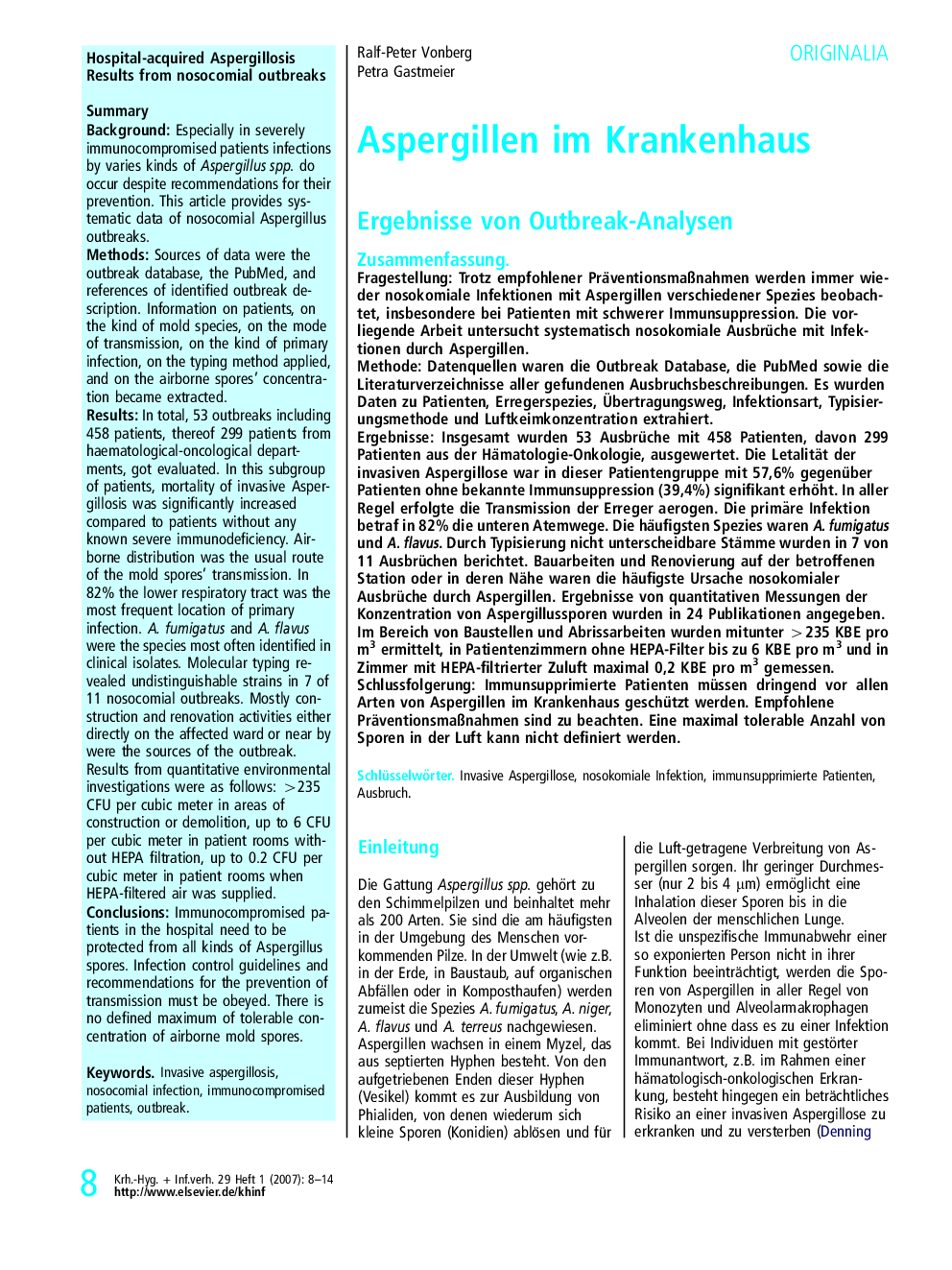| کد مقاله | کد نشریه | سال انتشار | مقاله انگلیسی | نسخه تمام متن |
|---|---|---|---|---|
| 2681707 | 1142453 | 2007 | 7 صفحه PDF | دانلود رایگان |

ZusammenfassungFragestellungTrotz empfohlener Präventionsmaßnahmen werden immer wieder nosokomiale Infektionen mit Aspergillen verschiedener Spezies beobachtet, insbesondere bei Patienten mit schwerer Immunsuppression. Die vorliegende Arbeit untersucht systematisch nosokomiale Ausbrüche mit Infektionen durch Aspergillen.MethodeDatenquellen waren die Outbreak Database, die PubMed sowie die Literaturverzeichnisse aller gefundenen Ausbruchsbeschreibungen. Es wurden Daten zu Patienten, Erregerspezies, Übertragungsweg, Infektionsart, Typisierungsmethode und Luftkeimkonzentration extrahiert.ErgebnisseInsgesamt wurden 53 Ausbrüche mit 458 Patienten, davon 299 Patienten aus der Hämatologie-Onkologie, ausgewertet. Die Letalität der invasiven Aspergillose war in dieser Patientengruppe mit 57,6% gegenüber Patienten ohne bekannte Immunsuppression (39,4%) signifikant erhöht. In aller Regel erfolgte die Transmission der Erreger aerogen. Die primäre Infektion betraf in 82% die unteren Atemwege. Die häufigsten Spezies waren A. fumigatus und A. flavus. Durch Typisierung nicht unterscheidbare Stämme wurden in 7 von 11 Ausbrüchen berichtet. Bauarbeiten und Renovierung auf der betroffenen Station oder in deren Nähe waren die häufigste Ursache nosokomialer Ausbrüche durch Aspergillen. Ergebnisse von quantitativen Messungen der Konzentration von Aspergillussporen wurden in 24 Publikationen angegeben. Im Bereich von Baustellen und Abrissarbeiten wurden mitunter >235 KBE pro m3 ermittelt, in Patientenzimmern ohne HEPA-Filter bis zu 6 KBE pro m3 und in Zimmer mit HEPA-filtrierter Zuluft maximal 0,2 KBE pro m3 gemessen.SchlussfolgerungImmunsupprimierte Patienten müssen dringend vor allen Arten von Aspergillen im Krankenhaus geschützt werden. Empfohlene Präventionsmaßnahmen sind zu beachten. Eine maximal tolerable Anzahl von Sporen in der Luft kann nicht definiert werden.
SummaryBackgroundEspecially in severely immunocompromised patients infections by varies kinds of Aspergillus spp. do occur despite recommendations for their prevention. This article provides systematic data of nosocomial Aspergillus outbreaks.MethodsSources of data were the outbreak database, the PubMed, and references of identified outbreak description. Information on patients, on the kind of mold species, on the mode of transmission, on the kind of primary infection, on the typing method applied, and on the airborne spores’ concentration became extracted.ResultsIn total, 53 outbreaks including 458 patients, thereof 299 patients from haematological-oncological departments, got evaluated. In this subgroup of patients, mortality of invasive Aspergillosis was significantly increased compared to patients without any known severe immunodeficiency. Airborne distribution was the usual route of the mold spores’ transmission. In 82% the lower respiratory tract was the most frequent location of primary infection. A. fumigatus and A. flavus were the species most often identified in clinical isolates. Molecular typing revealed undistinguishable strains in 7 of 11 nosocomial outbreaks. Mostly construction and renovation activities either directly on the affected ward or near by were the sources of the outbreak. Results from quantitative environmental investigations were as follows: >235 CFU per cubic meter in areas of construction or demolition, up to 6 CFU per cubic meter in patient rooms without HEPA filtration, up to 0.2 CFU per cubic meter in patient rooms when HEPA-filtered air was supplied.ConclusionsImmunocompromised patients in the hospital need to be protected from all kinds of Aspergillus spores. Infection control guidelines and recommendations for the prevention of transmission must be obeyed. There is no defined maximum of tolerable concentration of airborne mold spores.
Journal: Krankenhaus-Hygiene + Infektionsverhütung - Volume 29, Issue 1, 15 March 2007, Pages 8–14